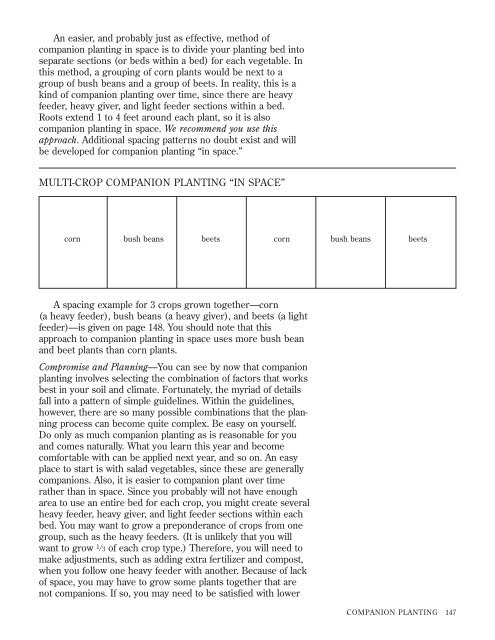How to Grow More Vegetables : And Fruits, Nuts ... - Shroomery
How to Grow More Vegetables : And Fruits, Nuts ... - Shroomery
How to Grow More Vegetables : And Fruits, Nuts ... - Shroomery
You also want an ePaper? Increase the reach of your titles
YUMPU automatically turns print PDFs into web optimized ePapers that Google loves.
An easier, and probably just as effective, method of<br />
companion planting in space is <strong>to</strong> divide your planting bed in<strong>to</strong><br />
separate sections (or beds within a bed) for each vegetable. In<br />
this method, a grouping of corn plants would be next <strong>to</strong> a<br />
group of bush beans and a group of beets. In reality, this is a<br />
kind of companion planting over time, since there are heavy<br />
feeder, heavy giver, and light feeder sections within a bed.<br />
Roots extend 1 <strong>to</strong> 4 feet around each plant, so it is also<br />
companion planting in space. We recommend you use this<br />
approach. Additional spacing patterns no doubt exist and will<br />
be developed for companion planting “in space.”<br />
MULTI-CROP COMPANION PLANTING “IN SPACE”<br />
corn bush beans beets corn bush beans beets<br />
A spacing example for 3 crops grown <strong>to</strong>gether—corn<br />
(a heavy feeder), bush beans (a heavy giver), and beets (a light<br />
feeder)—is given on page 148. You should note that this<br />
approach <strong>to</strong> companion planting in space uses more bush bean<br />
and beet plants than corn plants.<br />
Compromise and Planning—You can see by now that companion<br />
planting involves selecting the combination of fac<strong>to</strong>rs that works<br />
best in your soil and climate. Fortunately, the myriad of details<br />
fall in<strong>to</strong> a pattern of simple guidelines. Within the guidelines,<br />
however, there are so many possible combinations that the planning<br />
process can become quite complex. Be easy on yourself.<br />
Do only as much companion planting as is reasonable for you<br />
and comes naturally. What you learn this year and become<br />
comfortable with can be applied next year, and so on. An easy<br />
place <strong>to</strong> start is with salad vegetables, since these are generally<br />
companions. Also, it is easier <strong>to</strong> companion plant over time<br />
rather than in space. Since you probably will not have enough<br />
area <strong>to</strong> use an entire bed for each crop, you might create several<br />
heavy feeder, heavy giver, and light feeder sections within each<br />
bed. You may want <strong>to</strong> grow a preponderance of crops from one<br />
group, such as the heavy feeders. (It is unlikely that you will<br />
want <strong>to</strong> grow 1 ⁄ 3 of each crop type.) Therefore, you will need <strong>to</strong><br />
make adjustments, such as adding extra fertilizer and compost,<br />
when you follow one heavy feeder with another. Because of lack<br />
of space, you may have <strong>to</strong> grow some plants <strong>to</strong>gether that are<br />
not companions. If so, you may need <strong>to</strong> be satisfied with lower<br />
COMPANION PLANTING 147












